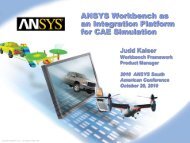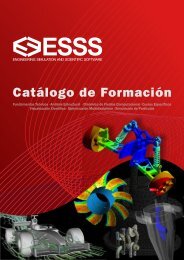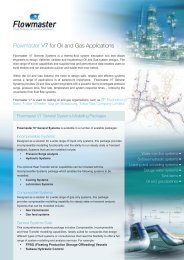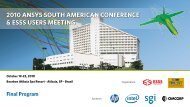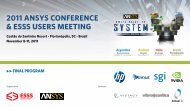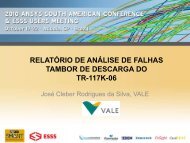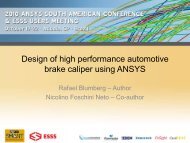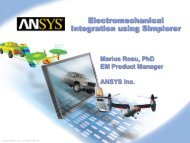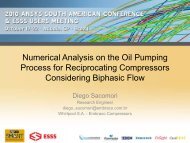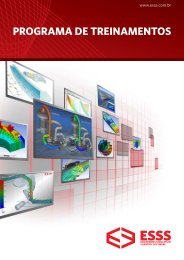FR-4 Substrate Integrated Waveguide PCB at 20GHz - ESSS
FR-4 Substrate Integrated Waveguide PCB at 20GHz - ESSS
FR-4 Substrate Integrated Waveguide PCB at 20GHz - ESSS
Create successful ePaper yourself
Turn your PDF publications into a flip-book with our unique Google optimized e-Paper software.
<strong>FR</strong>-4 <strong>Substr<strong>at</strong>e</strong> <strong>Integr<strong>at</strong>ed</strong> <strong>Waveguide</strong><br />
<strong>PCB</strong> <strong>at</strong> <strong>20GHz</strong><br />
Vanessa Przybylski Ribeiro Magri<br />
Centro de Estudos em Telecomunicações<br />
Labor<strong>at</strong>ório de Sistemas Ópticos, Microcircuitos e Microondas<br />
GSOM - CETUC / PUC-Rio<br />
Co-autores: Marbey Manhães Mosso – GSOM/ CETUC / PUC-Rio<br />
Rodolfo Araujo de Azevedo Lima – IPqM / Marinha do Brasil
Present<strong>at</strong>ion Topics<br />
• Problem Description: 1-Gb/s and 10-Gb/s <strong>PCB</strong><br />
• Methodology: Using HFSS 12 (Ansoft 3D Full-wave<br />
Electromagnetic Field Simul<strong>at</strong>ion) and Designer RF 5<br />
(Product Suites for RF and microwave circuits design with<br />
embedded HFSS EM simul<strong>at</strong>ion)<br />
• Comparison of experimental and simul<strong>at</strong>ed results<br />
• Conclusion and next steps.
Problem Description: 1-Gb/s and 10-Gb/s <strong>PCB</strong><br />
• High Speed digital circuits are being implemented with<br />
serial/parallel processing;<br />
• <strong>PCB</strong>s th<strong>at</strong> use the commercial substr<strong>at</strong>e (<strong>FR</strong>-4) in the above<br />
specified r<strong>at</strong>es demand high complexity electronic<br />
processing to solve the planar lines issues: loss, crosstalk,<br />
delay etc.;<br />
• Applic<strong>at</strong>ion of this work: to use <strong>Substr<strong>at</strong>e</strong> <strong>Integr<strong>at</strong>ed</strong> Wave<br />
Guides (SIWG) to replace planar lines in the inter-chip<br />
communic<strong>at</strong>ions on printed circuit boards.
SIWG mapped to a RWG<br />
Length ( L)<br />
Width (a) :<br />
center-to-center distance<br />
between via holes =<br />
wave guide width = 13.8 mm<br />
Length (L)<br />
d<br />
p<br />
f cTE10 = 5.3 GHz<br />
λ fcTE10 = 27.6 mm<br />
d<br />
Width (a)<br />
Width (a)<br />
• Cooper metalliz<strong>at</strong>ion<br />
thickness (t=0.035mm ) (top and bottom)<br />
• Dielectric thickness (h =1.575mm)<br />
•Dielectric constant (r = 4.3 <strong>FR</strong>-4)<br />
(inside)<br />
•Wall of metalized via-holes with<br />
diameter (d=1.7 mm)<br />
• Center-to-center spacing of viaholes<br />
in the wall (p = 4.6 mm)<br />
Cooper<br />
metalliz<strong>at</strong>ion<br />
thickness (t)<br />
Dielectric thickness (h) with<br />
z<br />
propag<strong>at</strong>ion direction<br />
Rectangular<br />
Wave Guides<br />
(RWG)<br />
<strong>Substr<strong>at</strong>e</strong><br />
<strong>Integr<strong>at</strong>ed</strong><br />
<strong>Waveguide</strong><br />
(SIWG)<br />
wave guide thickness<br />
y<br />
wave guide width<br />
x<br />
dielectric constant (r)<br />
4
Simul<strong>at</strong>ed (HFSS) frequency response of the SIWG<br />
and equivalent phase
Prototype SIWG<br />
Manufactured using LPKF <strong>PCB</strong> prototyping machine<br />
Microstrip<br />
length to<br />
connector<br />
L c =<br />
20.00 mm<br />
SIWG length<br />
L =<br />
42.72 mm<br />
Microstrip<br />
length<br />
transition to<br />
waveguide<br />
L mg =<br />
9.10 mm<br />
Includes:<br />
• two SMA connectors;<br />
• microstrip / waveguide transition in <strong>FR</strong>4<br />
lossy substr<strong>at</strong>e<br />
Microstrip<br />
length to<br />
connector<br />
L c =<br />
20.00 mm<br />
Microstrip<br />
width<br />
W m =<br />
3.24 mm
Comparison of experimental measurement of<br />
fabric<strong>at</strong>ed prototype and 3-D EM simul<strong>at</strong>ion (HFSS)<br />
S – Parameters (dB)
Comparison of experimental measurement of<br />
fabric<strong>at</strong>ed prototype and 3-D EM simul<strong>at</strong>ion (HFSS)<br />
S – Parameters (Phase)
SIWG Filter – (equivalent circuit model)<br />
10-GHz center frequency with 1-GHz bandwidth<br />
•<strong>Waveguide</strong> length 1 and 5 – LT1 =LT5=10.00mm<br />
•<strong>Waveguide</strong> length 2 and 4 – LT2=LT4=7.22 mm<br />
(Center-to-center distance between d1 and d2)<br />
•<strong>Waveguide</strong> length 3 – LT3 = 8.28 mm<br />
(Center-to-center distance between d2 and d2)<br />
•<strong>Waveguide</strong> thickness – b=1.575 mm<br />
•<strong>Waveguide</strong> width - a= 13.80mm<br />
(Center –to-center distance wall)<br />
•Via-hole diameters1 - d1= 0.50 mm<br />
•Via-hole diameters 2 – d2=1.90mm<br />
• Via –hole wall diameter d=1.7 mm<br />
•Center – to center via hole wall p=4.6 mm<br />
d 1<br />
d 2<br />
d 2<br />
d 1<br />
LT 1<br />
LT 2<br />
LT 3<br />
LT 4<br />
LT 5<br />
The model consists of five cascaded sections of the Rectangular <strong>Waveguide</strong> model<br />
altern<strong>at</strong>ed with four equivalent PI circuits model for each centered metalized via-holes.
Frequency response of SIWG filter<br />
centered <strong>at</strong> 10 GHz with 1 GHz bandwidth
Prototype SIWG Filter<br />
Microstrip<br />
length to<br />
connector<br />
L c =<br />
20.00 mm<br />
SIWG length<br />
L =<br />
42.72 mm<br />
Microstrip<br />
length<br />
transition to<br />
waveguide<br />
L mg =<br />
9.10 mm<br />
Microstrip<br />
length to<br />
connector<br />
L c =<br />
20.00 mm<br />
Microstrip<br />
width<br />
W m =<br />
3.24 mm
Comparison of experimental measurement of fabric<strong>at</strong>ed<br />
prototype Filter and 3-D EM simul<strong>at</strong>ion (HFSS)<br />
Frequency response of SIWG filter<br />
centered <strong>at</strong> 10 GHz with 1 GHz bandwidth
Comparison of experimental measurement of fabric<strong>at</strong>ed<br />
prototype Filter and 3-D EM simul<strong>at</strong>ion (HFSS)<br />
Phase of SIWG filter in the bandwidth
1-Gb/s digital circuit using SIWG <strong>FR</strong>-4 substr<strong>at</strong>e<br />
(Designer 5 / HFSS / experimental)<br />
Up-converter<br />
Down -converter
<strong>Waveguide</strong>:<br />
experimental measurement vs. simul<strong>at</strong>ion<br />
Comparison of experimental measurement and Simul<strong>at</strong>ed Spectrum<br />
response for 1 Gb/s NRZ form<strong>at</strong>s<br />
Propag<strong>at</strong>ed PRBs signal = up converter (10 GHz)
<strong>Waveguide</strong>:<br />
experimental measurement vs. simul<strong>at</strong>ion<br />
Comparison of experimental measurement and Simul<strong>at</strong>ed Spectrum<br />
response for 1 Gb/s NRZ form<strong>at</strong>s<br />
Received PRBs signal = down converter
Filter:<br />
experimental measurement vs. simul<strong>at</strong>ion<br />
Comparison of experimental measurement and Simul<strong>at</strong>ed Spectrum<br />
response for 1 Gb/s NRZ form<strong>at</strong>s<br />
Propag<strong>at</strong>ed PRBs signal = up converter
Filter:<br />
experimental measurement vs. simul<strong>at</strong>ion<br />
Comparison of experimental measurement and Simul<strong>at</strong>ed Spectrum<br />
response for 1 Gb/s NRZ form<strong>at</strong>s<br />
Received PRBs signal = down converter
10-Gb/s digital circuit using SIWG <strong>FR</strong>-4 substr<strong>at</strong>e<br />
(Designer 5 / HFSS / experimental)
<strong>Waveguide</strong>:<br />
experimental measurement vs. simul<strong>at</strong>ion<br />
Comparison of experimental measurement and Simul<strong>at</strong>ed Spectrum<br />
response for 10 Gb/s 16-QAM modul<strong>at</strong>ed NRZ form<strong>at</strong>s<br />
Propag<strong>at</strong>ed PRBs signal = up converter (10 GHz)
<strong>Waveguide</strong>:<br />
experimental measurement vs. simul<strong>at</strong>ion<br />
Comparison of experimental measurement and Simul<strong>at</strong>ed Spectrum<br />
response for 10 Gb/s 16-QAM modul<strong>at</strong>ed NRZ form<strong>at</strong>s<br />
Received PRBs signal = down converter
<strong>Waveguide</strong>:<br />
experimental measurement vs. simul<strong>at</strong>ion<br />
Comparison of experimental measurement and Simul<strong>at</strong>ed Eye Diagram /<br />
BER in 10 Gb/s 16-QAM modul<strong>at</strong>ed NRZ form<strong>at</strong>s<br />
Received PRBs signal = down converter
Conclusion and next steps<br />
• Using HFSS 12 (Ansoft 3D Full-wave Electromagnetic Field Simul<strong>at</strong>ion) and<br />
Designer RF 5 (Product Suites for RF and microwave circuits design with<br />
embedded HFSS EM simul<strong>at</strong>ion) a waveguide and a filter were modeled and<br />
simul<strong>at</strong>ed using a commercial <strong>FR</strong>-4 lossy dielectric substr<strong>at</strong>e, based on the<br />
concept of <strong>Substr<strong>at</strong>e</strong> <strong>Integr<strong>at</strong>ed</strong> Wave Guides (SIWG) to replace the planar lines<br />
in inter-chip 1Gb/s and 10Gb/s digital circuits. A set of measured experimental<br />
results was evalu<strong>at</strong>ed, showing excellent agreement with simul<strong>at</strong>ion predictions<br />
and far than s<strong>at</strong>isfactory performance.<br />
• The excellent results achieved indic<strong>at</strong>e th<strong>at</strong> several components oper<strong>at</strong>ing up to<br />
10 GHz (and maybe 20 GHz) could be realized with the commercial <strong>FR</strong>-4<br />
substr<strong>at</strong>e in the <strong>PCB</strong> inter-chip connections, employed in this work.<br />
• Besides this work, new applic<strong>at</strong>ions in telecommunic<strong>at</strong>ions ultra-fast electronics<br />
circuits involving BPSK, 16QAM and 64QAM modul<strong>at</strong>ion form<strong>at</strong>s associ<strong>at</strong>ed with<br />
10 Gb/s and 100 Gb/s waveguide propag<strong>at</strong>ion are being achieved in the our<br />
research center.
Acknowledgment<br />
This work was partially supported by Conselho Nacional de<br />
Desenvolvimento Científico e Tecnológico (CNPq), Brazil.<br />
The author is gr<strong>at</strong>eful to MOLOGNI, Juliano Fujioka ( <strong>ESSS</strong> - Engineering<br />
Simul<strong>at</strong>ion & Scientific Software) for comput<strong>at</strong>ional assistance.



